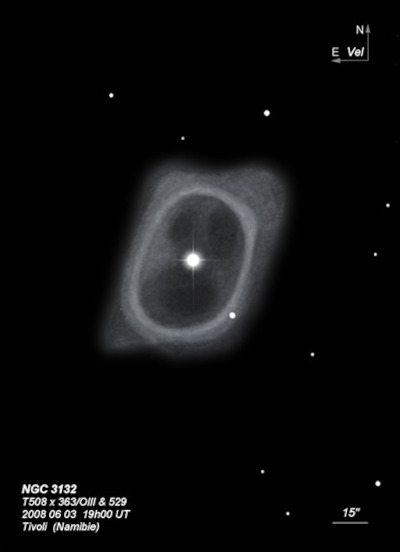Eight-Burst Nebula
Eight-Burst Nebula

John Herschel discovered NGC 3132 = h3228 on 2 Mar 1835 and recorded "Planetary nebula, very large, very bright, elliptic; has in it a 9th mag star somewhat excentric. Its light is exactly equable, ie. not increasing towards the middle; yet I cannot help imagining it to be closely dotted. It is just like a star out of focus in certain states of the mirror and atmosphere. Three stars near, a = 9th mag; b = 9th mag; c = 14th mag; A very extraordinary object." On a later observation he logged, "Planetary nebula with a 10th mag star in centre; very bright; very well defined, and perfectly equable all over in light, there being no condensation up to the centre. The star is sharp, the nebula velvety, or like infinitely fine dust; a star 14th mag at a distance rather more than a radius of neb from edge (by diagram); has its position from centre = 333.8°." Sketch on Plate VI, figure 9.
Herschel sketched NGC 3132 and other planetary nebulae from the Cape of Good Hope, commenting: "[these] represent planetary nebulae, a class of special interest, and of which, considering their general rarity, the southern heavens have afforded a rather unexpectedly large harvest. Those only are here delineated which have either accompanying stars, or which are distinguished by some peculiarity, as ... [NGC 3132] which has a star or a small disc near its centre". Father Angelo Secchi published a sketch (fig. 16) and description in 1856 using the 9.6" refractor in Rome. He called it a "beautiful and large ring nebula similar to that of the Hydra [NGC 3242]." William Lassell also made a sketch on 16 Apr 1862 through his 48-inch on Malta, showing an annual structure. He noted "the centre is bright and evidently stellar. There is a minute star touching the south preceding side of the nebula. Thie sides of the nebula are flattened and better defined than the ends."
In "Southern Gems", Stephen O'Meara states James Dunlop discovered NGC 3132 while making observations for the 1826 Brisbane Star Catalogue (published in 1835). In a footnote to #3085 he noted "Dusky Yellow - a fine Planetary disk." John Herschel recognized Dunlop's observation in a letter to Thomas Maclear in 1835.
A star (HD 87892) is plotted at the position of NGC 3132 in the first edition of the Uranometria 2000 because the BD catalogue (used as a source for the U2000) listed the bright "central" star as an entry. In 1977 Kohoutek and Laustsen announced (1978IAUS...76..207K) that the actual illuminating star is a hot, dim 16th magnitude companion to the mag 10 star at only 1.65" separation. The pair probably forms a true binary
The nickname "Eight Burst Nebula" was coined by H. Shapley and J. S. Paraskevopoulos in "Photographs of Thirty Southern Nebula and Clusters" (1940PNAS...26...31S). Concerning NGC 3132 they say: "A series of photographs of varying exposures would be necessary to bring out the intricate details…. It could well be named the "8-burst" planetary from the number of distinct arcs on the boundary of the main disk or shell".
200/250mm - 8" (3/28/81): mag 9 central star surrounded by a fairly bright, moderately large disc, striking.
300/350mm - 13" (2/23/85): darker around the central star at high power.
400/500mm - 17.5" (3/28/87): very bright, moderately large, oval. A dark ring surrounds the bright mag 10 central star. Viewed at only 10°-11° elevation.
Notes by Steve Gottlieb